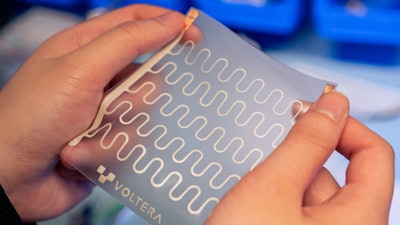
Voltera, a global leader and manufacturer of additive and printed electronics technology, today announced the launch of NOVA, a manufacturing platform for printing flexible hybrid electronics. NOVA uses direct-write technology to print circuits on soft, stretchable, and conformable surfaces.
“This first-of-its-kind benchtop machine unlocks rapid flexible hybrid electronics prototyping and the ability to experiment with custom inks and a wide variety of substrates,” said Alroy Almeida, CEO and co-founder of Voltera. “NOVA is already being used to innovate how humankind explores deep space, to develop printed, on-skin sensors for medical imaging, and to prototype clothing that can measure your heart rate yet can go through the gentle cycle in your washing machine.”
NOVA’s extrusion technology makes it easier and faster to conduct research and develop the products of the future by enabling rapid benchtop iteration, leading to more reliable results, faster development times, and lower costs.
"With NOVA, we can make devices and align them to sub 10-micron precision, which is essential to everything that we do,” said Alex Kashkin, Graduate Researcher, Velasquez Group at MIT, who is using NOVA to develop printed electron sources for neutralizing ionic thruster plumes in low-earth orbit. “If we have a 20-micron deviation, our devices explode. We need a lot of precision, we need to have tuned materials, and NOVA enables both."
While subtractive methodologies are great for traditional electronics, the future of electronics is flexible — and that means the future of electronics is additive. As a direct-write, digital printer, NOVA enables innovation without requiring the tooling and high costs associated with screen printing. This allows for rapid design iteration while offering higher performance than other additive prototyping options, such as inkjet. It is also better for the environment because there is significantly less waste and material contamination, and NOVA can print circuits on eco-friendly materials, such as biodegradable substrates.
Other features of NOVA include:
- Materials freedom: Simply fill NOVA’s Smart Dispenser cartridge with the desired material and use its semi-automated calibration procedure to start printing in minutes.
- Quick-swap work areas: Mount flexible substrates using the Vacuum Table module, or mount rigid substrates using custom fixturing.
- Precision dispensing: Print high-resolution features with realtime, closed-loop pressure feedback — no tooling or screens required.
- Integrated vision system: Align, print, and inspect quickly using an intelligent camera-based alignment and AR print overlay features.
- Modular platform: Built to include two quick-swap module ports, drop-in fixturing, and optional ethernet/USB/WiFi connectivity. Two modules are currently available with additional modules on the product roadmap.






















